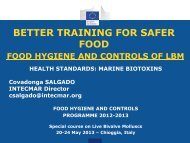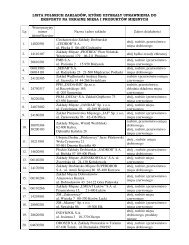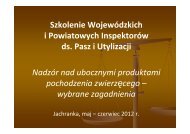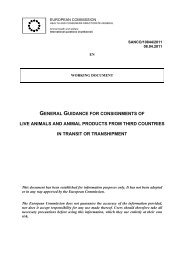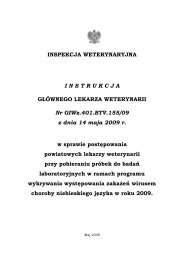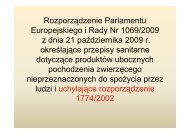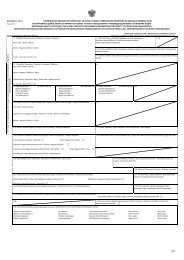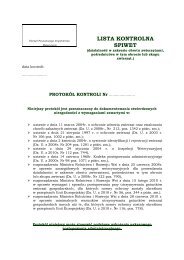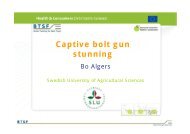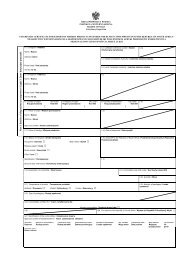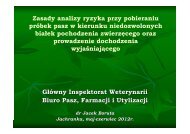FVO Audits on Live bivalve molluscs
FVO Audits on Live bivalve molluscs
FVO Audits on Live bivalve molluscs
You also want an ePaper? Increase the reach of your titles
YUMPU automatically turns print PDFs into web optimized ePapers that Google loves.
BETTER TRAINING FOR SAFER FOOD<br />
BTSF<br />
<str<strong>on</strong>g>FVO</str<strong>on</strong>g> <str<strong>on</strong>g>Audits</str<strong>on</strong>g> <strong>on</strong> <strong>Live</strong> <strong>bivalve</strong> <strong>molluscs</strong><br />
MARKUS BRUNNER<br />
FOOD HYGIENE AND CONTROLS<br />
PROGRAMME 2012-2013<br />
<strong>Live</strong> Bivalve Molluscs<br />
20 - 24 May 2013 – Chioggia, Italy<br />
Health and<br />
C<strong>on</strong>sumers
Health & C<strong>on</strong>sumers Directorate General<br />
DG SANCO<br />
Food and Veterinary Office<br />
Unit F3<br />
Food of animal origin:<br />
birds and fish<br />
Health and<br />
C<strong>on</strong>sumers
Health and<br />
C<strong>on</strong>sumers
Organisati<strong>on</strong> and Staff F3<br />
• Total staff: 22<br />
• Management and coordinati<strong>on</strong><br />
• Head of Unit: Stefan Hönig<br />
• Assistant to HoU: Jakub Hrabák<br />
• Administrative support<br />
• Report Coordinator: Gearóid Mathews<br />
• Assistants<br />
Gráinne Ní Chuirc<br />
Margaret Prendergast<br />
Catherine Davern<br />
Maria Rusu<br />
• Inspecti<strong>on</strong> resources: 15 staff organised in 2<br />
sectors (8 in fish and 7 in poultry)<br />
Health and<br />
C<strong>on</strong>sumers
THE FISH SECTOR<br />
Health and<br />
C<strong>on</strong>sumers
The Fish team<br />
Head of Sector: Graham Wood<br />
Auditors:<br />
• Åsa Bergquist<br />
• Bruno Brigaudeau<br />
• Markus Brunner<br />
• Ana G<strong>on</strong>calves<br />
• Miguel Mendes<br />
• Julia Uriol<br />
• Pedro Moreno Valenzuela<br />
• Telmo Valinhas<br />
Health and<br />
C<strong>on</strong>sumers
<strong>Live</strong> <strong>bivalve</strong> <strong>molluscs</strong><br />
mussels, oysters, clams<br />
mussels, oysters, clams<br />
live echinoderms, tunicates and marine gastropods<br />
Health and<br />
C<strong>on</strong>sumers
Key areas of focus when auditing<br />
(LBM)<br />
Public health c<strong>on</strong>trols all al<strong>on</strong>g the food chain for<br />
live <strong>bivalve</strong> <strong>molluscs</strong>:<br />
• producti<strong>on</strong> areas,<br />
• dispatch centres,<br />
• purificati<strong>on</strong> centres,<br />
• m<strong>on</strong>itoring programmes (microbiological<br />
c<strong>on</strong>taminati<strong>on</strong>, marine biotoxins,<br />
c<strong>on</strong>taminants),<br />
• laboratories,<br />
• processing establishments,<br />
• own checks, etc.<br />
Traceability<br />
Certificati<strong>on</strong> (third countries)<br />
Health and<br />
C<strong>on</strong>sumers
<str<strong>on</strong>g>FVO</str<strong>on</strong>g> specific MS audits for LBM<br />
Member State Date of visit Report<br />
Ireland 9-20 May 2011 2011-6007<br />
France 12-23 September 2011 2011-8882<br />
Spain 10-21 October 2011 2011-8881<br />
Greece 11-21 October 2011 2011-8883<br />
United Kingdom 16-27 April 2012 2012-6469<br />
Netherlands 17-27 April 2012 2012-6468<br />
Sweden 29 May-7 June 2012 2012-6545<br />
Italy 16–26 October 2012 2012-6542<br />
Denmark 12-19 November 2012 2012-6526<br />
Portugal September 2013 2013-6667<br />
Germany October 2013 2013-6668<br />
Health and<br />
C<strong>on</strong>sumers
<str<strong>on</strong>g>FVO</str<strong>on</strong>g> specific audits for LBM<br />
Findings/observati<strong>on</strong>s<br />
COMPETENT AUTHORITY<br />
Staff resources/technical competence<br />
Co-ordinati<strong>on</strong> co-operati<strong>on</strong> between resp<strong>on</strong>sible services<br />
CCA regard classificati<strong>on</strong>/m<strong>on</strong>itoring as overly burdensome<br />
Debate between more prescriptive legislati<strong>on</strong>/guidelines and the<br />
opti<strong>on</strong> to develop approach suited to their own marine<br />
envir<strong>on</strong>ment.<br />
Health and<br />
C<strong>on</strong>sumers
CLASSIFICATION OF PRODUCTION AREAS<br />
• Improvement since 2004. Discussi<strong>on</strong>s in working groups in<br />
relati<strong>on</strong> to sanitary surveys (e.g. re-evaluati<strong>on</strong> cycles)<br />
• Tolerance in A areas for e.coli above 230 MPN (already<br />
discussed in working groups – EURL making evaluati<strong>on</strong>)<br />
• Maintenance of classificati<strong>on</strong> with n<strong>on</strong>-adequate data<br />
• Lack of sanitary surveys or reclassificati<strong>on</strong> without re-evaluati<strong>on</strong><br />
• Geographical distributi<strong>on</strong> of sampling points not clearly<br />
defined/identified (representative for area?)<br />
• Sampling technique unreliable<br />
• CEFAS good practice guide not fully taken into account<br />
Health and<br />
C<strong>on</strong>sumers
CONTROL/MONITORING OF CLASSIFIED PRODUCTION AREAS<br />
General m<strong>on</strong>itoring: Official samples taken by FBO and in some cases<br />
from n<strong>on</strong>-representative (e.g. during harvesting) or insufficient number<br />
of locati<strong>on</strong>s<br />
• Representative for viruses?<br />
Widespread weaknesses in the m<strong>on</strong>itoring of biotoxins (most MS<br />
visited)<br />
• Not all relevant biotoxins determined<br />
• Reduced frequency or sporadic biotoxin testing (sometimes <strong>on</strong>ly when<br />
there are unfavourable plankt<strong>on</strong> results) without adequate risk analysis<br />
• M<strong>on</strong>itoring does not cover all toxin producing plankt<strong>on</strong> species<br />
Tolerance applied to biotoxin results for indicator species (if "sentinel" –<br />
no tolerance")<br />
Biotoxin/plankt<strong>on</strong> m<strong>on</strong>itoring – clear rati<strong>on</strong>ale for the timing?<br />
Health and<br />
C<strong>on</strong>sumers
CONTROL/MONITORING OF PECTINIDAE<br />
HARVESTED OUTSIDE CLASSIFIED<br />
PRODUCTION AREAS<br />
Official c<strong>on</strong>trols <strong>on</strong> pectinidae/gastropods harvested outside classified<br />
producti<strong>on</strong> areas are not carried out, or carried out incorrectly<br />
• (legislati<strong>on</strong> well adapted to this situati<strong>on</strong>? – challenging situati<strong>on</strong> -<br />
extensive producti<strong>on</strong> in small volumes from multiple suppliers)<br />
• M<strong>on</strong>itoring for ASP not carried out c<strong>on</strong>sidering limits in Regulati<strong>on</strong><br />
853/2004 and methods defined in Regulati<strong>on</strong> 2074/2005<br />
Health and<br />
C<strong>on</strong>sumers
Establishments<br />
• Lack of validati<strong>on</strong> of the effectiveness of water treatment for<br />
purificati<strong>on</strong> in FBOs or not performed as foreseen (particularly<br />
relevant for "B" areas)<br />
• Issues remain with end-product testing FBO/CA<br />
Health and<br />
C<strong>on</strong>sumers
Laboratories/analytical issues<br />
• Official samples taken by FBOs not CCA<br />
• Biotoxin methods – significant improvement since 2004.<br />
Infrequently - methods not in scope of accredited/<br />
validati<strong>on</strong> awaited/n<strong>on</strong> recognised method<br />
• A few laboratories were not accredited<br />
Health and<br />
C<strong>on</strong>sumers
For discussi<strong>on</strong><br />
• Is it necessary to check toxins, c<strong>on</strong>taminants and microbiology (Reg<br />
854/2004, D.2) at all stages of producti<strong>on</strong>, processing and<br />
distributi<strong>on</strong>?<br />
• Do sampling points need to be fixed to be as representative as<br />
possible?<br />
• Status of the EURL guidelines?<br />
• How big an influence is cost <strong>on</strong> analytical work performed by MS CA?<br />
• Is c<strong>on</strong>sistency maintained between producti<strong>on</strong> areas classified<br />
before changes introduced by the "hygiene package" and those<br />
classified more recently.<br />
• Guidance needed in relati<strong>on</strong> to phytoplankt<strong>on</strong> and biotoxins?<br />
• Different interpretati<strong>on</strong> for decisi<strong>on</strong>s after m<strong>on</strong>itoring (e.g. area<br />
closure v mitigating measures such as obligatory purificati<strong>on</strong>).<br />
Health and<br />
C<strong>on</strong>sumers
Unit F3.01 Fish sector<br />
Risks associated with LBM<br />
• C<strong>on</strong>taminants<br />
• Heavy metals (Pb, Cd, Hg)<br />
• Dioxins and dioxin-like PCBs<br />
• Parasites ?<br />
• Listeria m<strong>on</strong>ocytogenes: ready-to-eat products (smoked<br />
shellfish)<br />
• Salm<strong>on</strong>ella: cooked molluscan shellfish<br />
• E.coli<br />
• Vibrio parahaemolyticus, V. vulnificus<br />
• Campylobacter<br />
• Viruses: Norovirus, Hepatitis A,…<br />
• Biotoxins: Lipophilic toxins (Okadaic acid, Azaspiracids,<br />
Yessotoxins, Pectenotoxins, Dinophysistoxins), Amnesic<br />
toxins (ASP – Domoic acid), Paralytic toxins (PSP -<br />
Saxitoxins)<br />
• Other biotoxins: Neurolytic toxins (NSP), Palytoxin,…<br />
Health and<br />
C<strong>on</strong>sumers
Unit F3.01 Fish sector<br />
Risk associated with fish and LBM – RASFF<br />
RASFF 2011 from third countries<br />
RASFF 2011 from Member States<br />
Bad temperature c<strong>on</strong>trol 97 C<strong>on</strong>taminants 58<br />
C<strong>on</strong>taminants 95 Microbiological c<strong>on</strong>taminati<strong>on</strong> FP 54<br />
Parasites 77 Parasites 40<br />
Failed physical check in BIP 58 Microbiological c<strong>on</strong>taminati<strong>on</strong> LBM 18<br />
Histamine 27 C<strong>on</strong>taminati<strong>on</strong> with marine biotoxins 11<br />
Residues 24 Failed physical check 8<br />
Microbiological c<strong>on</strong>taminati<strong>on</strong> FP 17 Packaging - labelling defects 7<br />
Packaging – labelling defects 11 Histamine 6<br />
Absence – irregular certificate 9 Additives 6<br />
Additives 6 Residues 3<br />
Microbiological c<strong>on</strong>taminati<strong>on</strong> LBM 5 Illegal operati<strong>on</strong> 1<br />
Illegal operati<strong>on</strong> 3 212<br />
C<strong>on</strong>taminati<strong>on</strong> with marine biotoxins 1<br />
430<br />
Health and<br />
C<strong>on</strong>sumers
Thank you for your attenti<strong>on</strong>!<br />
Health and<br />
C<strong>on</strong>sumers



